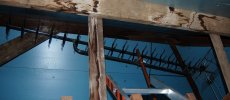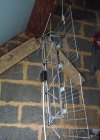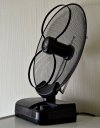You are using an out of date browser. It may not display this or other websites correctly.
You should upgrade or use an alternative browser.
You should upgrade or use an alternative browser.
Anteena dvb t2
- Thread starter solly
- Start date
- Joined
- May 1, 1999
- Messages
- 38,331
- Reaction score
- 1,642
- Points
- 113
- My Satellite Setup
- Technomate 5402 HD M2 Ci, DM7000s, Transparent 80cm Dish, Moteck SG2100 DiseqC motor, lots of legacy gear. Meters: Satlook Digital NIT, Promax HD Ranger+ spectrum analyser.
- My Location
- Berkshire
One of the very best UHF antennae for weak signals is the Televes DAT BOSS, pulls signal out of nowhere. DAT Series - Intelligent (with BOSSTech) - Terrestrial Antennas - TV DISTRIBUTION
Indoor aerials are mostly over rated, some of the ones made for caravans and boats are OK.
Indoor aerials are mostly over rated, some of the ones made for caravans and boats are OK.
EnoSat
Specialist Contributor
- Joined
- May 29, 2004
- Messages
- 822
- Reaction score
- 768
- Points
- 93
- Age
- 53
- Website
- enosat.euweb.cz
- My Satellite Setup
- TBS-5925/5220/5520SE , Dr.HD , Dreambox , Edision , Mutant , Octagon
- My Location
- Slovakia
Use an external antenna
Fisty McB
Member
- Joined
- Aug 11, 2012
- Messages
- 442
- Reaction score
- 652
- Points
- 93
- My Satellite Setup
- See my signature...
- My Location
- County Tyrone, N. Ireland
If you're looking for terrestrial DVB-T(2) reception and indoors in a room is too weak, the only practical option is to either go outdoors or, if favourable & desired, putting an antenna in the loft/attic.
I'm relatively lucky in that I can pick up DTT from a transmitter more than 70km away on my bedroom TV with a simple unamplified indoor aerial, but that's thanks to having favourable conditions (upstairs room, home lies quite high to surrounding near terrain and that the path from transmitter to receiver is almost line-of-sight).
In my experience, indoor amplified antennas are nearly always a waste of electric & money - there are some very occasional examples where they can help but more often than not they do no better than a reasonably well designed indoor aerial that makes the best of its inherent limitations. And where an indoor amplified antenna has been shown to work when unamplified aerials don't, they always are just about over the signal-to-noise threshold of reception and suffer easily from impulse noise, giving a "brittle" signal.
The Televes DAT BOSS antennas that rolfw linked to makes the best use of electrical amplification by not only integrating the amp within the active receiving element of the antenna (reducing losses & mismatches) but also putting it on an antenna that's designed to be put up high outdoors which is what really needs to be done before any "suck it & see" amplification should be done.
I must say though that in my experience, with the general ease of receiving out-of-area TV these days via satellite & internet, as well as DVB-T(2) allowing frequencies to be reused at closer distances than what was needed in the days of analogue broadcasting and thus blocking more distant signals from being received either often or occasionally, the general hobby of VHF & UHF TV DXing is largely gone now except for a few hardy souls that are still going.
I'm relatively lucky in that I can pick up DTT from a transmitter more than 70km away on my bedroom TV with a simple unamplified indoor aerial, but that's thanks to having favourable conditions (upstairs room, home lies quite high to surrounding near terrain and that the path from transmitter to receiver is almost line-of-sight).
In my experience, indoor amplified antennas are nearly always a waste of electric & money - there are some very occasional examples where they can help but more often than not they do no better than a reasonably well designed indoor aerial that makes the best of its inherent limitations. And where an indoor amplified antenna has been shown to work when unamplified aerials don't, they always are just about over the signal-to-noise threshold of reception and suffer easily from impulse noise, giving a "brittle" signal.
The Televes DAT BOSS antennas that rolfw linked to makes the best use of electrical amplification by not only integrating the amp within the active receiving element of the antenna (reducing losses & mismatches) but also putting it on an antenna that's designed to be put up high outdoors which is what really needs to be done before any "suck it & see" amplification should be done.
I must say though that in my experience, with the general ease of receiving out-of-area TV these days via satellite & internet, as well as DVB-T(2) allowing frequencies to be reused at closer distances than what was needed in the days of analogue broadcasting and thus blocking more distant signals from being received either often or occasionally, the general hobby of VHF & UHF TV DXing is largely gone now except for a few hardy souls that are still going.
- Joined
- Jan 1, 2000
- Messages
- 36,005
- Reaction score
- 8,717
- Points
- 113
- Age
- 60
- Website
- www.sat-elite.uk
- My Satellite Setup
- A little less analogue, and a lot more crap.
- My Location
- UK
I am fitting one to the roof once it gets a bit warmer.One of the very best UHF antennae for weak signals is the Televes DAT BOSS, pulls signal out of nowhere. DAT Series - Intelligent (with BOSSTech) - Terrestrial Antennas - TV DISTRIBUTION
Indoor aerials are mostly over rated, some of the ones made for caravans and boats are OK.
LeBelge
Member
- Joined
- May 14, 2015
- Messages
- 316
- Reaction score
- 171
- Points
- 43
- My Satellite Setup
- 2x Triax TD 110, 2x Edision OS Mio 4K (plus), Edision OS Mini 4K, Edision OS Nino Pro
- My Location
- Belguim
Spc..
Member
- Joined
- Dec 31, 2017
- Messages
- 347
- Reaction score
- 198
- Points
- 43
- My Satellite Setup
- TeVii S2 Tuners, 138cm Gibertini + 100cm backup dish
- My Location
- Slovenia
I am using diamond antenna that my father bought 30 years ago, range is 25-1300MHz.
I get all frequencies from FM radio, dab, dvb-t, t2, police, fire brigade, you name it.
This is external only antenna.
Model is Super Discone Antenna D130 original Made in JAPAN:
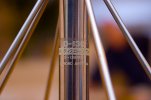
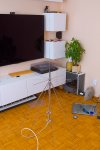
Above 70dB for FM:

DVB-T (100%):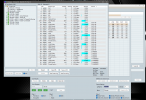
DAB+ transmitter 189km away (Austria MUX) 20 dB:

I get all frequencies from FM radio, dab, dvb-t, t2, police, fire brigade, you name it.
This is external only antenna.
Model is Super Discone Antenna D130 original Made in JAPAN:


Above 70dB for FM:

DVB-T (100%):

DAB+ transmitter 189km away (Austria MUX) 20 dB:

Last edited:
- Joined
- Jan 1, 2000
- Messages
- 36,005
- Reaction score
- 8,717
- Points
- 113
- Age
- 60
- Website
- www.sat-elite.uk
- My Satellite Setup
- A little less analogue, and a lot more crap.
- My Location
- UK
Butterfly antennas are highly underrated.
Fisty McB
Member
- Joined
- Aug 11, 2012
- Messages
- 442
- Reaction score
- 652
- Points
- 93
- My Satellite Setup
- See my signature...
- My Location
- County Tyrone, N. Ireland
I am using diamond antenna that my father bought 30 years ago, range is 25-1300MHz.
I get all frequencies from FM radio, dab, dvb-t, t2, police, fire brigade, you name it.
This is external only antenna.
Model is Super Discone Antenna D130 original Made in JAPAN:
View attachment 152994
View attachment 152995
Above 70dB for FM:
View attachment 152996
Discones are good for wideband reception over a very large frequency range, but their gain is very low (something like an average of 0 dbi). If indoor DVB-T reception isn't possible in a given location, I'd doubt a discone (even one that covers the required frequencies) even mounted outdoors will be of much practical use. Fine where you could otherwise pick up many strong signals with a piece of wire, but that's why they're often employed for use where frequency coverage is more important than raw gain.
Also discone antennas are vertically polarised - I don't know the details of the DVB-T transmissions in Solly's location of Tel Aviv, but if all the wanted transmissions horizontally polarised then a discone won't be much good for this use.
Spc..
Member
- Joined
- Dec 31, 2017
- Messages
- 347
- Reaction score
- 198
- Points
- 43
- My Satellite Setup
- TeVii S2 Tuners, 138cm Gibertini + 100cm backup dish
- My Location
- Slovenia
My model is omni, vertical+horizontal.Also discone antennas are vertically polarised
i added new images on my original post.
for DAB+ and DVB-T iam using simple dvb realtek usb dongle for 12€.
for FM, SONY ST-D777ES high end tuner.
Last edited:
solly
Specialist Contributor
- Joined
- Apr 18, 2004
- Messages
- 6,616
- Reaction score
- 3,814
- Points
- 113
- Age
- 54
- My Location
- Tel Aviv, Israel
I use horizontaly dvbt 26 dvbt and dvbt2 ch 28 both octagon not found signalDiscones are good for wideband reception over a very large frequency range, but their gain is very low (something like an average of 0 dbi). If indoor DVB-T reception isn't possible in a given location, I'd doubt a discone (even one that covers the required frequencies) even mounted outdoors will be of much practical use. Fine where you could otherwise pick up many strong signals with a piece of wire, but that's why they're often employed for use where frequency coverage is more important than raw gain.
Also discone antennas are vertically polarised - I don't know the details of the DVB-T transmissions in Solly's location of Tel Aviv, but if all the wanted transmissions horizontally polarised then a discone won't be much good for this use.

